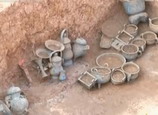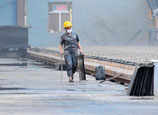
Locals walk slowly on the wall, more like a daily routine, while visitors stay busy shooting pictures as swallows fly low. The mountain in the distance rises between mist and clouds like a fairyland.
The walk, which takes around three hours, is also cooler because of the greenery, humidity, mist and occasional drizzle.
Aside from other scenes along the journey, I was greatly impressed by the Chenghuang Temple located at the foot of the middle section of the wall.
It wasn't the temple itself that intrigued me, but a large and ancient tree that caught my attention. Only half of the 1,300-year-old camphor tree is left, the other half having been destroyed a hundred years ago by lightning. It still continues to thrive today, however. Over the years, millions of people who visited have tied red ribbons on it, with hopes and good wishes. How many stories have been witnessed by this tree? More than a thousand years - what a life it has had!
In the far northeast of the city wall is the Temple of Heaven built by Fang Guozhen, a farmer whose assault on officials of the Yuan Dynasty (1271-1368) helped overthrow an empire.
It is used as a place to offer sacrifice to heaven. The whole structure is similar to the famous Temple of Heaven in Beijing, with its centerpiece a temple complex. It also used semicircular and square shapes to symbolize the heavens and the Earth, reflecting an ancient Chinese saying that "Heaven is round and the Earth is square."
Flood control
At the end of the city wall, you come to the Jiangnan Badaling scenic spot. As the name suggests, this part of the wall is similar to the Badaling Great Wall in Beijing, becoming steep as it hugs the mountain. The wall appears to descend into the Ling River. The roaring river breaks the peace of the journey, bringing local life to you as fishing boats sound their horns.
Another important role that the wall has played is flood control. One third of the city wall was built along the Ling River for a reason. The ancient Taizhou government was located near the estuary of Ling River, and the water would flood the city when the river met the incoming tide and the water level rose.
The city wall is like a big dam that stood against the flood for a thousand years. For this reason, the builders took special measures in the design of the Linhai city wall and changed the shape of the wall to a semicircle where it met the water, a design that is the only one of its kind remaining in China and that was quite rare among ancient city walls. Beacon towers were erected at strategic points along the wall.
The Yuan Dynasty emperor ordered the destruction of all the city walls in the Jiangnan region after he defeated the Song Dynasty (960-1279), so his army could march into the area easily.
Only the Linhai city wall survived because of its flood control function.
Ziyang old street
At the end of the city wall lies Ziyang old street. The 1,080-meter-long street is the longest well-preserved historical block in China. Home to many venerable wood and stone buildings and time-honored shops, the street is a living relic in today's Linhai City. The street is very quiet and local residents still keep to their traditional daily routines: An old grandmother sits on a small stool in front of her house, taking in the early summer sunshine; a housewife makes lunch for her family on a traditional stove; a vendor sells local delicacies; two grandfathers chat in an ancient-looking barber shop while waiting to get their hair trimmed. Once one of the primary commercial blocks in Taizhou, the street plays an important part in Linhai's historical and cultural preservation.
If you go...
There are bullet trains operating from Shanghai that go to Linhai, including the D5482, D3104, D3208, D5456, D5590, D3114 and D5560 trains. The trip takes about four hours.
The ticket for the Taizhou city walls is 50 yuan.

















 Quadruplet sisters and their family
Quadruplet sisters and their family


![]()
